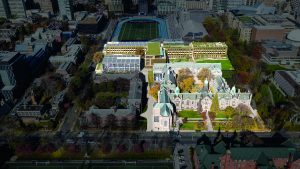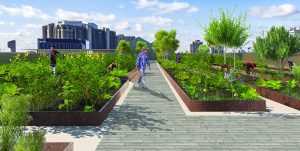LIVING LAB

U of T’s sustainability advisor on how Trinity’s new building will be “on the frontier” of what’s possible
By Cynthia Macdonald
John Robinson believes that universities have a key role to play in the fight for a more sustainable future: They are “living labs” where the best ideas can be tried and tested.
And since ideas often take shape in campus buildings, he also thinks it’s crucial that those buildings set an example themselves. In his current position as U of T’s Presidential Advisor on the Environment, Climate Change and Sustainability, Robinson ’75 is helping to lead the creation of Trinity’s extraordinary new building. Making use of the most advanced thinking in carbon reduction, energy and water use, and construction materials—among many other measures—it promises not only to be one of the greenest on the continent, but to set an example for others to follow.
Trinity Fellow, member of the Trinity College Senate, and professor at the Munk School of Global Affairs and Public Policy, as well as U of T’s School of the Environment, Robinson has spent many years encouraging students, faculty and non-academic partners to live sustainable lives. A decade ago, he led the creation of a building known as the Centre for Interactive Research on Sustainability (CIRS) at the University of British Columbia. Adding CIRS has reduced UBC’s carbon emissions, improved the health, productivity and wellbeing of its inhabitants, harvested rainwater for irrigation, and set a new standard for energy efficiency.
Today, realizing an even more sustainable building at Trinity is just one of the ways in which Robinson is leading the fight for sustainability at U of T. Recently, we spoke to him about his commitment to this most critical of present-day concerns.
For the past three years, you’ve been teaching a special course at the Munk School. In fact, the idea for Trinity’s roof garden came directly out of ENV461: U of T as a Living Lab of Sustainability, which itself was inspired by the success of an initiative by Trinity student Mbonella Phiri-Nkomo, who grew several pots of tomatoes and peppers on the St. Hilda’s roof in the summer of 2017. By producing a variety of vegetables locally, Trinity has really been able to contribute to a more sustainable food system. In your opinion, what makes this course different from others?
JR It’s different in that students don’t read literature and write essays—they actively solve problems brought to them by clients across the campus. These are real-world problems, in which clients meet with students every week for the entire term. What we’re also doing is fostering relationships with non-academic partners. We want to co-produce solutions with people in the community and not just lecture at them, telling them what the problems are.
We started Trinity’s rooftop garden in the first year, and last year implemented an irrigation system. In 2019, students undertook a “post-occupancy evaluation” in the Larkin building in preparation for the new building, and this year students are developing ideas for a monitoring plan for the building.
In what ways can universities set an example for others on the sustainability front?
JR Universities have several characteristics that no other institution has, and together they make a powerful combination. We’re single-owner occupiers of significant capital stock; we operate at a neighbourhood scale; and we can accept longer paybacks on our investments than the market can.
Most importantly, we teach and we do research—so we can turn our whole campus into a sandbox and try things out, then make those lessons available to industry. We have a unique opportunity to be a societal test bed for the most cutting-edge sustainability initiatives. There are more than 10,000 universities around the world, and my dream is that they will all get the bit between their teeth and go with it. We have to move quickly on this, because the need is urgent.
I think Trinity has really stepped up in this respect. Its new building won’t just meet sustainability standards or improve on them slightly: It will be on the frontier of what’s possible. This building will be a hive of research in every respect, from paint and glazing, to carpeting, to food production, to human comfort and well-being, to mass timber construction, to heating, energy and water performance.
Why are sustainable buildings so important?
JR If you add up all the construction activity, as well as material and energy use over the building’s lifetime, that’s a big chunk of our total carbon emissions. But it’s actually more than that. Because sustainability is about the environment, of course, but it’s also about human well-being. Can we make buildings that make people happier, healthier and more productive, as well as improving the environment they’re in? The evidence shows we can.
In what ways do they do those things for people?
JR Some of the big advantages are air quality, natural light, access to nature—and just being aware you’re in a sustainable building. That in itself makes people feel good. In fact it’s such a powerful effect that when we did studies of recycling behaviour in CIRS, we found that people were recycling much more there than in more standard buildings with the same facilities.
Only a handful of buildings in the world will be as sustainable as this one. Do you hope that one day, they’ll become the standard?
JR That’s exactly what we want: A building that, when it opens, is a showcase, but then within five years is being surpassed by others in the community. In the end, we want to be superseded by buildings that are even better.
Sustainability can improve general well-being. And yet, paradoxically, there is a great deal of anxiety around climate change and environmental threats. The subject can also provoke great pain.
JR We need to convey a feeling of hope. As environmentalists, if our whole message is ‘it’s only going to get worse,’ how are people going to feel? They’re not going to feel empowered to take action. A new building like this can act as a very positive symbol, however, because it demonstrates so many ways in which we can take action. It isn’t inevitable doom—there are plenty of things you can do. One action isn’t going to change the world, but it’s part of the puzzle: It’s going to be many, many things acting together that transform our environment. Real change is coming; the level of concern has never been as high as it is now.

In everything from the rooftop garden to urban beehives to energy reduction initiatives, students are at the forefront of environmental change at Trinity. They benefit directly in many ways as well—for example, the sale of energy from the solar panels on the Gerald Larkin Building generates $25,000 per year for student bursaries. In 2018, the Butterfield Environment & Sustainability Stream started as part of the Margaret MacMillan Trinity One program. What kinds of other initiatives are available (or being planned) for students at Trinity and across U of T?
JR Because this is so important to students, we want to ensure that every student at U of T will be offered a sustainability pathway as part of their own program. Whether it’s civil engineering or medieval history, it doesn’t matter, because every career has sustainability dimensions. For example, green accounting and green dentistry are burgeoning fields. Students, as well as all members of society, need to get educated about how their particular fields affect other people and the environment. And Trinity’s Ethics, Society and Law and International Relations programs are both offering new, mandatory sustainability courses this academic year, which is exciting.
Trinity itself has a very active student society, and what we’re trying to do now is organize the student engagement. The Living Lab projects are one way in which we’ve done that. I can also tell you a wonderful recent story involving five students, three of whom came from Trinity.
This group approached me and said, “we want to do something.” So I found funding, and hired them to do four inventories—on all the courses, clubs, community engagement activities and extracurricular activities at the university that had sustainability content. They first wrote up an indispensable report, which I now use in my committee work. Next, they presented an abstract of that report at the International Sustainable Campus Network conference in Stockholm. They also wrote an article, submitted it to a refereed journal, got it published and won an award. Of course, all of this is very unusual for undergraduates.
So you see this wave of student activities that is actually making a big difference: it’s very positive and empowering. Again, we need to give our students hope, but not just by telling them the situation is hopeful. What’s important is providing them with real-world opportunities to do things. Because we have an unbelievable student body, which is both highly concerned and willing to engage.
As published Trinity Magazine Fall 2020

Sorry, comments are closed for this post.